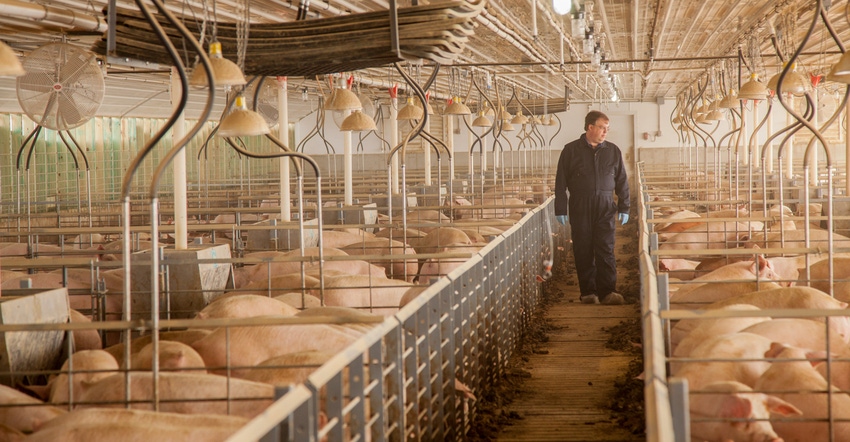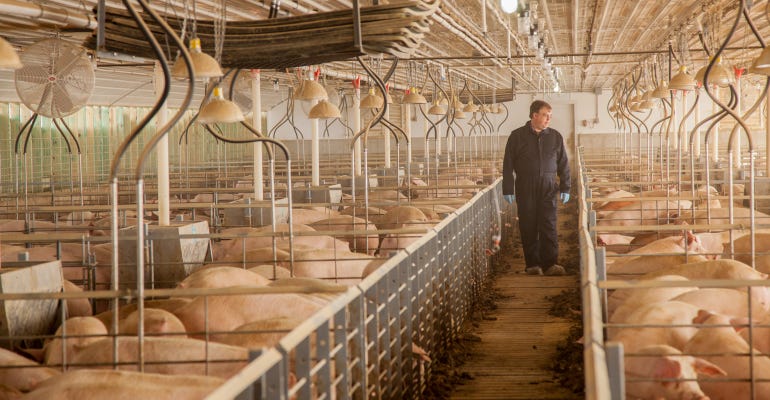Will changing weather lead to increased salmonella in your herd?
Salmonella — a common enteric disease affecting swine herds — is one of those diseases to watch for as temperatures begin to change.
April 10, 2018

Sponsored Content
After the implementation of the Veterinary Feed Directive in 2017, producers are no longer using antibiotics in animal feed for growth promotion. As a result, subclinical disease pressure may be exposed. Salmonella — a common enteric disease affecting swine herds —is one of those diseases to watch for as temperatures begin to change. Pigs tend to shed more Salmonella organisms in cool, humid conditions, leading to increased chances of disease exposure throughout the herd. Salmonella bacteria can be found anywhere within a swine operation and will replicate in the pig’s gut. If barns are not properly cleaned and disinfected between groups, the bacteria can contaminate newly placed pigs. Most commonly, clinical Salmonellosis is found in finishing swine (50-250 pounds) of at least 8 weeks of age. Robyn Fleck, D.V.M., Merck Animal Health, discusses the disease and tips for detection and prevention. “Subclinical Salmonellosis may have been masked in the past by some antibiotics, and it now may start coming to the forefront.”
Signs and symptoms
Fleck says Salmonellosis must be confirmed by culture and presence of telltale tissue lesions since the most common symptom, diarrhea, is often mistaken for other illnesses such as ileitis, dysentery or low-grade Rota or Corona viruses. In extreme cases, Salmonella-affected swine may become septicemic (blood poisoning) leading to red-tinged extremities, fever and respiratory distress. If you suspect this, contact your veterinarian. “Diarrhea can reduce average daily gain and increase feed conversion because it is damaging the cells of the gut, preventing nutrients from being well absorbed,” says Fleck. “This can be very costly on finishing pigs where rapid growth is expected.” Fleck encourages diagnostics on fecal samples as well as post-mortems on diarrheic pigs to learn more about the specific disease affecting the pig or herd.

Prevention is key
Many diarrhea-causing organisms are spread throughout the environment of pigs, so the most important preventive step is to properly sanitize and disinfect the whole barn. Fleck says producers should make sure the whole barn, including the dust from walls and rafters, is washed down and disinfected between groups of pigs. “Salmonella is not uncommon,” says Fleck. “On large finishing sites, studies indicated that 18.8% of the herds had a positive culture for Salmonella. However, it is a dose-related disease. Just because it is on the farm doesn’t mean animals will get Salmonellosis, but stressful conditions can result in it becoming clinical and spreading.” Fleck emphasizes that producers should always take steps to reduce stress in animals. Animals that are stressed may release cortisol which can increase the ability of Salmonella to replicate in the pig. The more organisms shed, the greater the risk of spreading to other animals. “Reduce humidity in your barns to 50-70%, don’t over-crowd animals and avoid large fluctuations in temperature. In addition, step up the rodent controls, as rats and mice try to enter barns in cold weather and can carry the disease. Also, maintaining proper dunging patterns in barns with open flush gutters or solid concrete floors is key,” Fleck adds. Since sanitation and animal husbandry are not always enough, a Salmonella vaccine can help herds susceptible to the disease. Argus® (sc/st/ with diluent), from Merck Animal Health, works to aid in the prevention of pneumonia, diarrhea, septicemia and mortality caused by Salmonella choleraesuis and as an aid in control of disease caused by Salmonella typhimurium and an aid in control of Salmonella typhimurium shedding. Administered orally through drinking water, the product is intended for animals older than 3 weeks of age. “Sanitation and vaccination are the most important factors to consider,” says Fleck. If you suspect that Salmonella has spread through your herd, work with your veterinarian to determine the right steps to take. Veterinarians need to diagnose clinical disease in the barn before prescribing antibiotics. “You can control a lot just by keeping the pig’s environment clean,” says Fleck. “But sometimes things happen that are out of your control and you have to add a Salmonella vaccination to your program.”
About the Author(s)
You May Also Like



